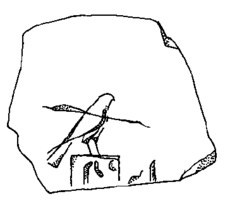Bird (king)
| Bird in hieroglyphics | |
|---|---|
|
Fragment of calcite - Alabaster , the king "bird" is awarded |
Vogel is the makeshift name of an ancient Egyptian king ( Pharaoh ) of the 1st dynasty , who lived around 2850 BC. Could have ruled.
Almost nothing is known about this ruler. His possible kinship and family affiliation are just as unclear and debatable as his chronological position in the early dynasties .
Name and identity

Even with the name of this regent there is great uncertainty in Egyptology because the very few artifacts that could prove its existence are badly damaged or the name of the ruler was written extremely carelessly, so that the name hieroglyph cannot be clearly identified.
The majority of Egyptologists, including Wolfgang Helck and Peter Kaplony , at least agree that the bird-like figure in Serech is a goose-like bird. Helck therefore reads the name as "Hor Sa" ( G38 ) or "Hor Geb" ( G39 ).
The Egyptologist Nabil Swelim, on the other hand, reads the name as "Hor Ba" ( G29 ).
Finds and their possible interpretations
It is extremely difficult for archaeologists and Egyptologists to assign this ruler exactly in chronological order , as King “Vogel” is only documented by three vessel fragments on which his name appears: The shard RTII pl.8A, 6 was made by Flinders Petrie in the tomb of King Qaa in Abydos discovered. Only the upper part of the Serech and the Horus falcon are preserved on it. The vessel fragments PDIV n.97 and PDIV n.108, on the other hand, were found in Saqqara and have become quite illegible due to abrasion, whereby the bird shape is very clearly visible on the latter shard.
Since a building appears on the vessel fragments from Saqqara, which so far is only known from the reign of Qaa, various Egyptologists, such as Peter Kaplony , assume that King "Vogel" reigned after Qaa for a very short time. The name of King Sneferka falls at the same time as "Vogel" and is believed to be chronologically between Qaa and Hetepsechemui .
According to Helck and Kaplony, there seems to have been disputes over the throne between King “Vogel” and Seneferka, which culminated in the fact that the royal cemetery of Abydos was closed and even publicly plundered. Corresponding traces and finds were discovered by Walter Bryan Emery . This also explains why, on the one hand, lists of rulers on stone vessels end abruptly with Qaa and, on the other hand, royal burials have been moved to Saqqara. The founder of the 2nd dynasty , King Hetepsechemui , perhaps used military force against the two rulers, triumphed and at least had the tomb of Qaa restored. The names of king "Vogel" and Sneferka do not appear in later king lists. Wolfgang Helck adds that Sneferka and "Vogel" were apparently banned from the later records due to their illegimacy , as their power struggles caused the dynasty to perish.
literature
- Walter Bryan Emery: Great Tombs of the First Dynasty. Volume III, Government-Press 1949.
- Wolfgang Helck: History of Ancient Egypt. Brill, Leiden 1981, ISBN 978-90-04-06497-3 .
- Jochem Kahl : Inscriptional Evidence for the Relative Chronology of Dyn. 0-2. In: Erik Hornung, Rolf Krauss, David A. Warburton (eds.): Ancient Egyptian Chronology (= Handbook of Oriental studies. Section One. The Near and Middle East. Volume 83). Brill, Leiden / Boston 2006, ISBN 978-90-04-11385-5 , pp. 94-115 ( online ).
- Peter Kaplony: "He is a favorite of women" - a "new" king and a new theory about the crown prince and the goddesses of the state (crown goddesses) of the 1st / 2nd. Dynasty. In: Egypt and the Levant XIII - International Journal for Egyptian Archeology and related disciplines. 2004.
- Nabil Swelim: Some Problems on the History of the Third Dynasty. In: Archaeological and Historical Studies Volume 7, The Archaeological Society of Alexandria, Alexandria 1983.
Web links
- Francesco Raffaele: Bird / Vogel
Individual evidence
- ^ Pierre Lacau, Jan-Phillip Lauer: La Pyramide a Degrees. Volume IV: Inscriptions Gravees sur les Vases: Fouilles à Saqqarah. Service des antiquités de l'Égypte, Cairo 1936, p. 108, fig. 8.
- ^ Jürgen von Beckerath : Handbook of the Egyptian king names . In: Munich Egyptological Studies . Vol. 49. von Zabern, Mainz 1999, ISBN 3-8053-2591-6 , pp. 46-49.
- ↑ P. Lacau, J.-P. Lauer: Pyramid Degrees. Volume IV, p. 108, Fig. 7.
- ^ Francesco Raffaele: Bird / Vogel
- ↑ Wolfgang Helck: History of Ancient Egypt. Pp. 34-35.
- ^ Nabil Swelim: Some problems on the history of the second dynasty . Pp. 66-77.
- ↑ Jochem Kahl: The system of Egyptian hieroglyphic writing in the 0th to 3rd dynasty . Pp. 7-10.
- ↑ Peter Kaplony: "He is a favorite of women" . Pp. 107-126.
- ↑ Wolfgang Helck: History of Ancient Egypt . P. 39.
- ^ Walter Bryan Emery: Great Tombs of the First Dynasty . Pp. 28-31.
- ↑ Peter Kaplony: "He is a favorite of women". Pp. 126-127.
- ↑ Wolfgang Helck : Investigations on the Thinite Age (= Ägyptologische Abhandlungen. (ÄA) Vol. 45). Harrassowitz, Wiesbaden 1987, ISBN 3-447-02677-4 , p. 117.
| predecessor | Office | successor |
|---|---|---|
| unsure |
Pharaoh of Egypt 1st Dynasty |
unsure |
| personal data | |
|---|---|
| SURNAME | bird |
| ALTERNATIVE NAMES | Hor Sa; Hor Geb; Hor Ba; Ba I. |
| BRIEF DESCRIPTION | ancient Egyptian king of the 1st dynasty |
| DATE OF BIRTH | uncertain: 30th century BC BC or 29th century BC Chr. |
| DATE OF DEATH | uncertain: 29th century BC BC or 28th century BC Chr. |
